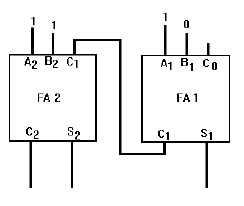3-9
of 0 and a carry (C2) of 1. By reading the outputs (C2, S2, and S1), we see that the sum of 112 and 012 is
1002.
Figure 3-10. —Parallel addition.
As you know, the highest binary number with two digits is 112. Using the parallel adder, let’s add
11
2
and 112.
First, apply the addend and augend to the A and B inputs. Calculate the output of each full adder
beginning with full adder 1. With A1 and B1 at 1, S1 is 0 and C1 is 1. Since all three inputs (A2, B2, and C1)
to full adder 2 are 1, the output will be 1 at S2 and 1 at C2. The output of the circuit, as you read left to
right, is 1102, the sum of 112 and 112.
Parallel adders may be expanded by combining more full adders to accommodate the number of
digits in the numbers to be added. There must be one full adder for each digit.
Q6. What advantage does a half adder have over a quarter adder?
Q7. An X-OR gate may be used as what type of adder?
Q8. What will be the output of a half adder when both inputs are 1s?
Q9. What type of adder is used to handle a carry from a previous circuit?
Q10. How many full adders are required to add four-digit numbers?
Q11. With the inputs shown below, what will be the output of S1, S2, and C2?



